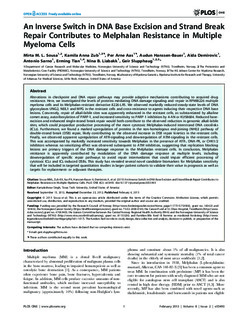An inverse switch in DNA base excision and strand break repair contributes to melphalan resistance in multiple myeloma cells
Sousa, Mirta; Zub, Kamila Anna; Aas, Per Arne; Hanssen-Bauer, Audun; Demirovic, Aida; Sarno, Antonio; Tian, Erming; Liabakk, Nina-Beate; Slupphaug, Geir
Journal article, Peer reviewed
Permanent lenke
http://hdl.handle.net/11250/298844Utgivelsesdato
2013Metadata
Vis full innførselSamlinger
Sammendrag
Alterations in checkpoint and DNA repair pathways may provide adaptive mechanisms contributing to acquired drug resistance. Here, we investigated the levels of proteins mediating DNA damage signaling and -repair in RPMI8226 multiple myeloma cells and its Melphalan-resistant derivative 8226-LR5. We observed markedly reduced steady-state levels of DNA glycosylases UNG2, NEIL1 and MPG in the resistant cells and cross-resistance to agents inducing their respective DNA base lesions. Conversely, repair of alkali-labile sites was apparently enhanced in the resistant cells, as substantiated by alkaline comet assay, autoribosylation of PARP-1, and increased sensitivity to PARP-1 inhibition by 4-AN or KU58684. Reduced base-excision and enhanced single-strand break repair would both contribute to the observed reduction in genomic alkali-labile sites, which could jeopardize productive processing of the more cytotoxic Melphalan-induced interstrand DNA crosslinks (ICLs). Furthermore, we found a marked upregulation of proteins in the non-homologous end-joining (NHEJ) pathway of double-strand break (DSB) repair, likely contributing to the observed increase in DSB repair kinetics in the resistant cells. Finally, we observed apparent upregulation of ATR-signaling and downregulation of ATM-signaling in the resistant cells. This was accompanied by markedly increased sensitivity towards Melphalan in the presence of ATR-, DNA-PK, or CHK1/2 inhibitors whereas no sensitizing effect was observed subsequent to ATM inhibition, suggesting that replication blocking lesions are primary triggers of the DNA damage response in the Melphalan resistant cells. In conclusion, Melphalan resistance is apparently contributed by modulation of the DNA damage response at multiple levels, including downregulation of specific repair pathways to avoid repair intermediates that could impair efficient processing of cytotoxic ICLs and ICL-induced DSBs. This study has revealed several novel candidate biomarkers for Melphalan sensitivity that will be included in targeted quantitation studies in larger patient cohorts to validate their value in prognosis as well as targets for replacement- or adjuvant therapies.
Beskrivelse
- Published article
